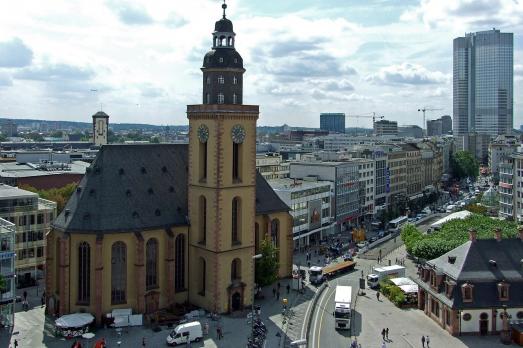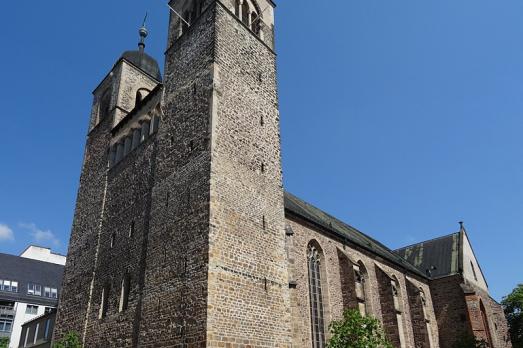
Katharinenkirche
Frankfurt, DE
St. Katharinen Church is a Protestant church in Frankfurt am Main. The Baroque building was built from 1678 to 1681 and rebuilt between 1950 and 1954 after being destroyed during the Second World War.
Here you can search for a building to visit. You can use the map find destinations, or you can use the filters to search for a building based upon what different criteria.

Frankfurt, DE
St. Katharinen Church is a Protestant church in Frankfurt am Main. The Baroque building was built from 1678 to 1681 and rebuilt between 1950 and 1954 after being destroyed during the Second World War.
Glane, NL
Former Roman Catholic St. Olaf's Monastery. Since 1981 this complex has been part of the Syriac Orthodox Church of St. Ephrem.
Haarlem, NL
The St. Bavo Cathedral was built in three phases between 1895 and 1930. The city of Haarlem received a bishop's seat in 1559. The current Grote or St. Bavo Church on the Grote Markt served as a cathedral from then on. Since the Reformation, that church has been in the hands of the Protestants.
s-Hertogenbosch, NL
The current St. John's Cathedral was built in the period 1280-1550 and initially served as a parish church. When the Diocese of 's-Hertogenbosch was founded in 1559, the church became a cathedral. Incidentally, the cathedral does not belong to the oldest parish on the current territory of 's-Hertogenbosch. That is the parish of St. Salvator in Orthen, which was founded before 1280. In the thirteenth century, the people of 's-Hertogenbosch were still dependent on the parish of Orthen. Around 1280, construction began on a separate parish church, which would later develop into the current cathedral.
Breda, NL
Beautiful neoclassical church with tower. Cathedral of the Diocese of Breda. This is the only remaining large Roman Catholic parish church in and around the centre of Breda. The parish of Breda-Centrum also uses the much smaller, also neoclassical, St. Catherine Chapel / Church on the Beguinage as a church building.
Rotterdam, NL
Cathedral of the Diocese of Rotterdam from the beginning of 1967. This Diocese was founded in 1956 as a "split-off" from the Diocese of Haarlem. Since then, the Diocese of Rotterdam has covered the province of South Holland.
Groningen, NL
Built as a Roman Catholic parish church of St. Joseph. This is an exceptionally important church building, particularly because of the unique, high, slender, hexagonal tower (76 m; according to various sources 78 m). Also a beautiful neo-Gothic church in terms of interior. Five-sided closed chapel on the west side of the chancel. Rectangular chapel against the side aisle on the east side of the chancel. Hexagonal tower next to the front facade, crowned by an openwork iron spire. The tower is popularly nicknamed "drunkemanstoren", because at least two clock faces are visible from each side. Since 1970, this church has officially been the cathedral of the Diocese of Groningen-Leeuwarden, which was (re)established in 1956. In 1970, the St. Martinuskathedraal was closed (and demolished in 1982).

Magdeburg, DE
The original church of Saint Sebastian was constructed in 1016, with various additions thereafter. The church's modern form took place after renovations in 1953 and 1959. It sustained damage during a fire in the 14th and 15th centuries, and during the thirty-years war.

Amersfoort, NL
Built as a Christian Reformed Church. To replace this church, the new Chr. Geref. Ichthus Church was built in the centre of Amersfoort.
Rotterdam, NL
Modest church with an interesting neo-Gothic facade.

new
The Chassidic Route is a cultural and historical trail tracing the rich legacy of Jewish communities in southeastern Poland and western Ukraine. This region was central to the rise of Chassidism in the 18th century. Here, we highlight 10 remarkable synagogues you’ll discover along this route.

he cradle of the Industrial Revolution in Germany, Chemnitz, is well-known for its industrial heritage landscape, but the city is also home to remarkable examples of religious architecture from different historical periods. Join us as we explore the key landmarks of this European Capital of Culture 2025.

The twin towns of Nova Gorica (Slovenia) and Gorizia (Italy), lying on the border between the two countries, have a rich religious heritage, steeped in centuries of tradition. If you are looking for ideas for your visit, take note of these 10 religious sites that you should not miss.